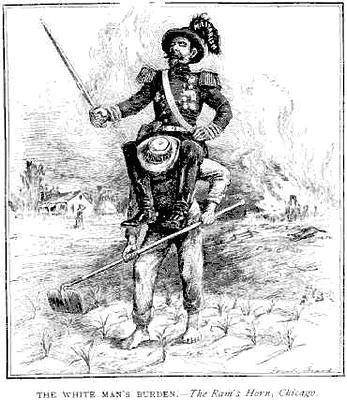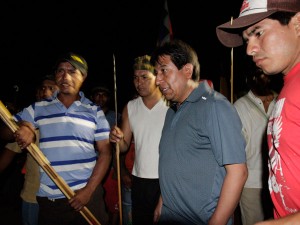Nov 18
20110
Democracy Centre, The International Campaign to Destabilize Bolivia, The War on Libya - There Was No Evidence
Bolivia CIDOB | Confederation of Indigenous People of Bolivia NED | National Endowment for Democracy The Democracy Center TIPNIS USAID
The West, the Rest and the Exploited (Bolivia, TIPNIS, USAID, CIDOB, NED, The Democracy Center)
The Western empires have their days numbered, not just because emerging countries are catching up to them, but because they have corrupted their own system and made it unsustainable.
Juan Carlos Zambrana Marchetti
November 18, 2011
The conservative British historian Niall Ferguson argues in his latest book, Civilization: The West and the Rest, that “beginning in the 15th Century, the West developed six powerful new concepts that the Rest lacked: competition, science, the rule of law, modern medicine, consumerism, and work ethic”. He argues that controlling these “Killer applications,… the West jumped ahead of the rest, opening global trade routes, exploiting new scientific knowledge, evolving representative government, more than doubling life expectancy, unleashing the industrial revolution… Western empires controlled 4/5 of the global economy”. What a story of exceptionalism.
What the British historian avoids putting into proper perspective is that, “by chance,” in the 15th Century there also took place the “discovery of the New World,” which led Europe into a new era of prosperity and the new colonies into one of genocide, slavery and plunder. It would be more honest to acknowledge that the six “applications” that the West monopolized were war, Illicit appropriation of labor, property and knowledge; the legalization of their spoils of war; control of the media to create a triumphalist history; and, to the present day, the evolution of their methods of control. But that only highlights the obvious misrepresentations. There are more subtle deceptions in Ferguson’s selective memory, such as the concepts of “evolution of representative government” and the “rule of law”.
The so-called “evolution” of representative government led to the fact that the people’s participation in democracy ends on Election Day, when they choose their president and their representatives to Congress. Through this mechanism, a bridle was put into the mouths of the people, mounted like donkeys, and the reins were turned over to the interest groups, who, financing election campaigns, literally bought the brand-new representatives. With 80 percent of the planet depending on the empires for trade, health, education, communications, food supply, religions, finance, and so on, It was easy for the empires to impose on not only their own countries, but also on most of the world, puppet governments to serve corporate interests.
The also misleading concept of “rule of law” hides, among other things, authorization for the empires to become “guardians” of compliance with this law, which they use as pretext to invade any country that interests them, as it happened in the case of Libya, a country which NATO bombarded mercilessly, then invaded, ironically, based on the pretext of protecting it. Pierre Charasse says in his article The west and the rest, or the myth of the international community, that “The Military intervention in Libya … had as a legal basis resolution 1973 of the United Nations Security Council, and as a moral foundation, the responsibility to protect the civilian population”.
The Western empires organized the circus of the world forums in order to herd into them the small countries that they influenced, to subject them to “laws” to which empires are not subject to. That was clear when the U.S. invaded Iraq unilaterally, and it is obvious each year when, in the United Nations, 186 countries vote to lift the blockade on Cuba, but in practice, loses to the U.S. vote and the lone support of Israel. Therefore, the so-called “evolution of representative government” and “Rule of Law” can also represent the evolution of the control mechanisms of imperialism.
Ferguson says that, “The days of Western predominance are numbered, because the Rest has finally downloaded the six killer apps the West once monopolized— while the West has literally lost faith in itself.” He fails to recognize that the collapse of the West is largely self-inflicted, because it corrupted its own system so much that it is now unsustainable. It totally deregulated itself, and gave itself license to unleash wars around the world, seeding the planet with death, misery and desolation with the only objective to increase its control, to continue plundering with impunity, ever increasing the gap between rich and poor. Five centuries were not enough, and they continue to do it, as in even into the 21st Century.
At a time when the political forces of the planet are changing polarity from the West to the emerging economies of Brazil, Russia, India and China, Bolivian President Evo Morales has called on the social organizations to discuss the second phase of the process of change, and to establish a new agenda for his government. It is important to analyze the case of Bolivia, because it is the other side of the equation in this Western exceptionalism described by Ferguson. Bolivia’s population, mainly indigenous, survived the above-mentioned five centuries of plundering and exploitation; as a result, the long period of resistance, in a vicious cycle of war between the forces of looting and the people’s attempts to defend themselves, has exposed the creative ways in which imperialism operates.
In my book Secrets of State I explain that, after the first Bolivian revolutionary government nationalized John D. Rockefeller’ s Standard Oil Co. for fraud on the Bolivian State, Nelson Rockefeller, the successor of the oil empire, then working at the State Department, realized that the Bolivian indigenous were becoming aware of their strength as a class and would soon claim their political space. Thus began an era of apparent U.S. cooperation, hidden under the disguise of philanthropy, with which to begin to control the indigenous. The U.S. also diversified its methods of control, introducing them to international lending institutions and the United Nations. An example of this was the case of the Andean Indian Program.
The United States could not prevent the historical Bolivian revolution of 1952, but having trapped the small Andean country into dependency, and having gotten into its bloodstream trough programs to “include” the natives, began to make them believe that they were supported while discreetly disfiguring the social reform plan with a skillful manipulation of the words used in legislation. In this way, it distorted the agrarian reform, because the idea of peasants owning the land and organizing productively was aberrant to the capitalist production system of “hacienda”, or large agricultural corporation, which the US promoted for political purposes in the eastern lowlands of Bolivia, creating a new right-wing ruling class to counter the anti-imperialism of the Andean region. Through other programs of “cooperation” the US strengthened and indoctrinated the Bolivian military, in preparation for the next generation of dictatorships.
Two tragic realities are clear in Bolivian history. One is that the U.S. has the undeniable objective of regime change on counties that resist its policies, and an extraordinary set of mechanisms to achieve it. The second is the consequence of the first: the people’s challenge is not only to come to power, but also, once there, to have to constantly defend their government. The Bolivian people have come to power, and have already put in place unprecedented changes, but I think that Morales’ government, before sitting down to talk with a legion of foreign interests, should investigate in depth the extent to which various social sectors have been infiltrated by USAID, which openly funded CIDOB, by the NED, and by the army of NGOs, with unfortunately has become another mechanism for hegemony to evade responsibilities.
An interesting case study is that of The Democracy Center, whose participation in support of the people in the Water War of 2000 was as commendable as is now its surprising dislike of Evo Morales. It seems as though it expected to emerge from that conflict with their own president, and the rise of Evo Morales thwarted their plans. The current benefactor of The Democracy Center is the Ford Foundation, but it is curious to find among its previous benefactors the Rockefeller Foundation: the same people who since the Second World War have been manipulating in different ways the will and the destiny of the Bolivian peasants, to use them politically in favor of the agenda of capitalism.
In the recent conflict over the construction of a highway through the TIPNIS indigenous territory, history repeated itself once again: indigenous people renounced all possibility of progress and integration in favor of the hidden political objective of the US to boycott the projects of crop-substitution and development center in the Chapare, wherein lies the core of the anti-imperialist consciousness of the Bolivian people. Once again, foreign interests have ensured that the Indians act against their own interests. This shows that a priority issue for the new agenda of president Morales should be to continue deconstructing the control mechanisms of the Western powers. “Philanthropy” has always been one of the most dangerous mechanisms.
http://juancarloszambrana.com/?page_id=452
http://politicalcontext.org/blog/2011/11/the-west-the-rest-and-the-exploited/



